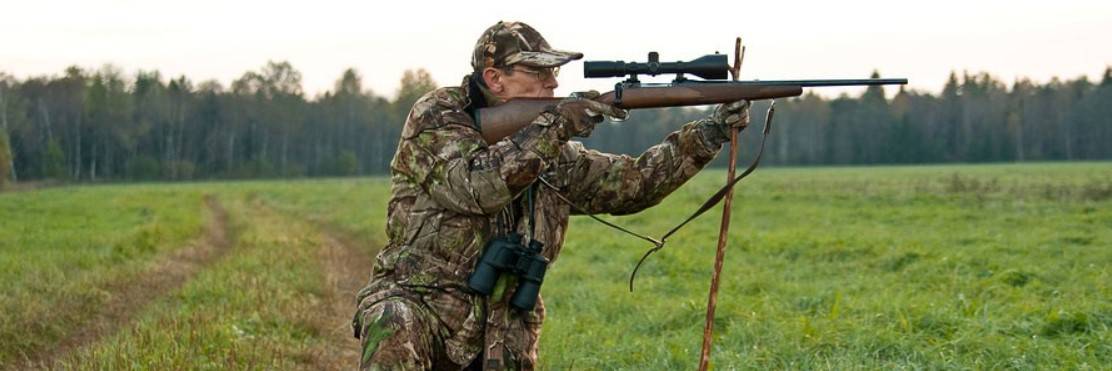Three years ago, I was sitting in a creek bottom stand in North Texas when a mature eight-point stepped out of the mesquite just as the sun was kissing the horizon. The shot was maybe 180 yards – not difficult for my .270 – but in that dim light, I couldn’t make out the deer clearly through my old scope. By the time I figured out he was legal, he’d melted back into the brush. That was the night I decided to get serious about deer scopes, and after testing hundreds of optics at Bass Pro and in my own hunting, I learned what really matters when that buck of a lifetime steps out at last light.
The truth is, most hunters overthink scope selection. You don’t need a $2,000 tactical scope with 47 different reticle options to kill deer. What you need is reliable glass that gathers light when deer move, holds zero when your rifle gets bounced around, and doesn’t fog up when you need it most. After years of testing scopes in real hunting conditions, I am confident the Leupold VX-Freedom 3-9×40 is the overall choice for most deer hunters.
The 4 Best Scopes for Deer Hunting
Best Overall
Leupold VX-Freedom 3-9×40
For most deer hunters, this is the scope. American-made reliability, excellent low-light performance, and the perfect magnification range for 95% of deer hunting situations. It’s what I’d put on my son’s first deer rifle, and what I reach for when I need one scope to do it all. At just 12.6 ounces, it won’t throw off your rifle’s balance, and the generous eye relief makes it forgiving when you’re shooting from awkward positions or wearing heavy winter clothes.
Best for Versatility
Vortex Diamondback 4-12×40
When you hunt everything from thick East Texas woods to open wheat fields, this scope’s 4-12x range gives you options. Good glass quality and Vortex’s unbeatable warranty make it a solid choice, though the tight eye relief takes some getting used to. The Dead-Hold BDC reticle provides reliable holdover points for longer shots, making it ideal for hunters who regularly shoot past 200 yards across varied terrain.<
Best Value for the Money
Bushnell Banner 2 3-9×40
If you’re getting started or hunting on a tight budget, the Banner gets the job done. The DDB coating really does help in low light, and it’s tough enough to handle a hard hunt. Not fancy, but it works when it counts. The improved optical design over the original Banner delivers noticeably better clarity, and Bushnell includes quality aluminum rings in the box, which saves you money right out of the gate.
Premium Reliability Choice
Trijicon Huron 3-9×40
Built to military specifications with legendary Trijicon durability. When you need a scope that will survive anything and hold zero forever, this is it. Premium price but premium performance to match. This scope passed the brutal Rokslide drop test and delivers exceptional glass clarity that rivals optics costing significantly more, making it the choice for serious hunters who refuse to compromise on reliability.
Why You Can Trust My Recommendations
I’m Mike Fellon, and I’ve been helping hunters find the right optics for over 15 years. Started hunting deer with my dad, John, in the Texas Hill Country when I was barely tall enough to see over the shooting rail. Those early mornings taught me that deer hunting is all about being ready for that one perfect moment – usually when the light is terrible and you’ve got seconds to make the shot.
During my five years working the firearms counter at Bass Pro Shops, I helped hundreds of deer hunters choose scopes before opening day. I saw the same mistakes over and over: guys buying too much magnification, choosing busy tactical reticles, or going so cheap their scope fogged up on the first cold morning. After leaving Bass Pro, I started ScopesReviews to share what I’d learned helping real hunters solve real problems.
I’ve tested over 200 rifle scopes, but when it comes to deer hunting, I always come back to the same principles my dad taught me: reliability trumps features, simple beats complex, and if you can’t see your target clearly in the last 20 minutes of legal light, you’ve got the wrong scope.
The Numbers That Actually Matter
Here are the key numbers, though for deer hunting, I care most about weight (you’ll carry it all day), objective diameter (more light in dim conditions), and eye relief (comfort and safety). The maximum magnification matters less than you’d think – most deer are shot on 6x or lower.
| Specification | Leupold VX-Freedom 3-9×40 | Vortex Diamondback 4-12×40 | Bushnell Banner 2 3-9×40 | Trijicon Huron 3-9×40 |
|---|---|---|---|---|
| Magnification Range | 3-9x | 4-12x | 3-9x | 3-9x |
| Objective Lens | 40mm | 40mm | 40mm | 40mm |
| Weight | 12.6 oz | 14.6 oz | 14.8 oz | 15.8 oz |
| Eye Relief | 4.2-3.7 inches | 3.1 inches | 3.3 inches | 2.5-3.7 inches |
| Field of View | 33-11 feet @100 yards | 32.4-11.3 feet @100 yards | 37.5-12.2 feet @100 yards | 33.8-11.3 feet @100 yards |
| Tube Diameter | 1 inch | 1 inch | 1 inch | 1 inch |
| Adjustment | 1/4 MOA clicks | 1/4 MOA clicks | 1/4 MOA clicks | 1/4 MOA clicks |
| Reticle | Duplex (SFP) | Dead-Hold BDC (SFP) | DOA Quick Ballistic (SFP) | BDC Hunter Holds (SFP) |
The 4 Best Deer Hunting Scopes
1. Leupold VX-Freedom 3-9×40 – Best Overall for Deer Hunting
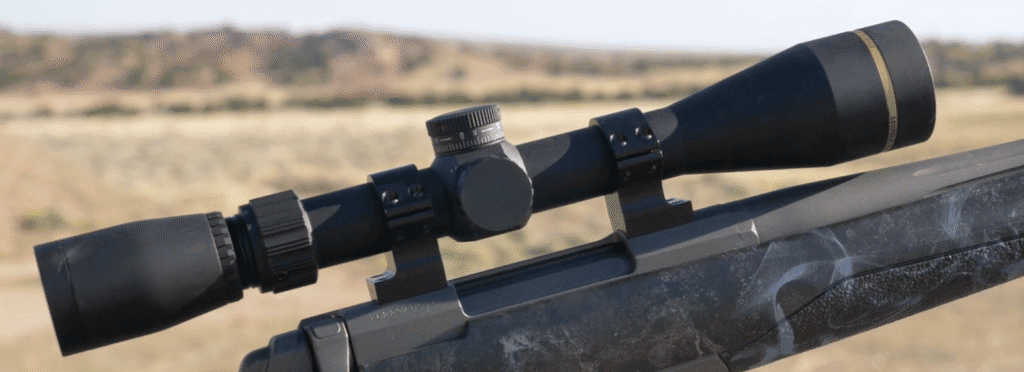
| Specification | Details |
|---|---|
| Magnification Range | 3-9x |
| Objective Lens | 40mm |
| Weight | 12.6 oz |
| Eye Relief | 4.2-3.7 inches |
| Field of View | 33-11 feet @100 yards |
| Tube Diameter | 1 inch |
| Adjustment | 1/4 MOA clicks |
| Reticle | Duplex (SFP) |
| Warranty | Lifetime |
On the Range and In the Field
Sighting in the VX-Freedom on my Tikka .308 was straightforward – three shots to get on paper, five more to dial it in perfectly at 100 yards. After burning through 40 rounds of .30-06 during load development, the zero hadn’t budged a click. But the real test came during three cold December mornings in my favorite creek bottom stand.
On the third morning, a nice eight-point stepped out of the oak thicket 20 minutes before sunrise. Even in that gray light with heavy cloud cover, I could clearly see his rack through the Duplex reticle. The crosshairs were sharp and bold against his shoulder, and when I squeezed the trigger at 165 yards, he dropped in his tracks. That’s what separates the VX-Freedom from cheaper glass – when legal shooting light is fading fast, you can still make the shot.
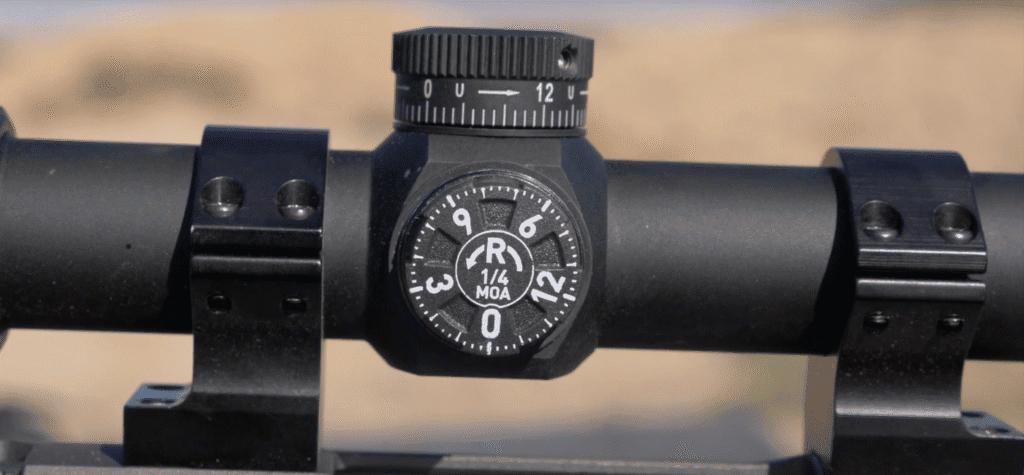
What I Like About It
The glass quality is the standout feature here. Leupold’s Advanced Optical System delivers light transmission that rivals scopes costing twice as much. The eye relief is generous and forgiving – critical when you’re shooting from awkward positions in a cramped box blind or when adrenaline has your form less than perfect. The simple Duplex reticle is bold enough to see in dim light but fine enough for precise shot placement, and being made in the USA with that legendary Leupold lifetime warranty gives me confidence this scope will outlast several rifles.
What Could Be Better
The eye box tightens up noticeably at 9x magnification, though for deer hunting you’ll rarely need that much power anyway. The turrets are capped, which some hunters see as a limitation, but for a set-and-forget deer scope, I actually prefer them protected. My only real complaint is that Leupold cheapened the packaging – this scope deserves better than a cardboard box, especially at this price point.
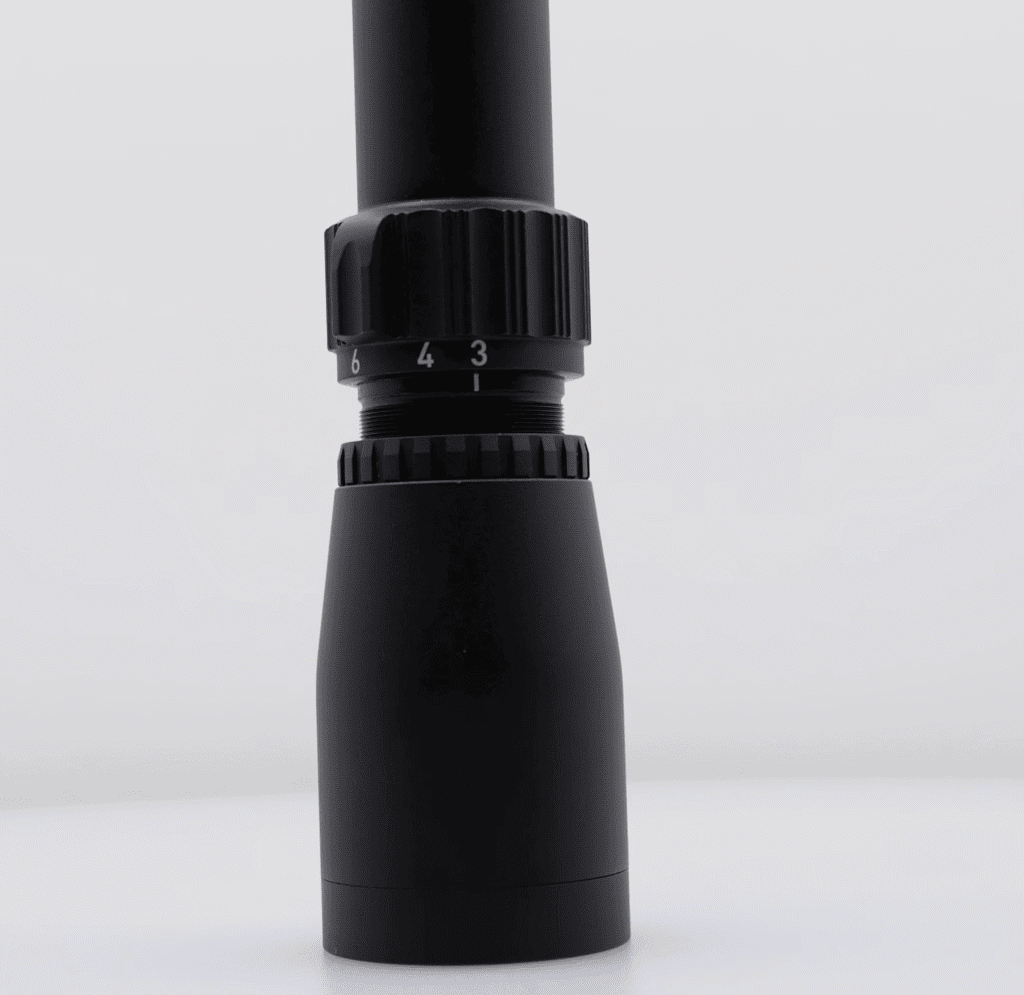
Build Quality and What It Can Take
To test durability, I accidentally knocked my rifle over while getting out of the truck at camp – the scope hit the rocky ground pretty hard. After checking zero at the range, it was still dead-on. The VX-Freedom also sat through a three-hour drizzle during an afternoon hunt with no internal fogging whatsoever. The nitrogen purging and O-ring sealing work as advertised. The tube feels solid and the controls operate smoothly even with wet hands.
Field Test Data
| Test Category | Performance | Notes |
|---|---|---|
| Low-Light Performance | 18 minutes past sunset | Could identify deer features clearly |
| Reticle Visibility | Excellent | Bold crosshairs visible against dark backgrounds |
| Zero Retention | Perfect | Held zero through 100+ rounds and drops |
| Waterproof Test | Passed | No fogging after 3-hour rain exposure |
| Eye Box Forgiveness | Very Good | Easy to get behind quickly at 3-6x |
| Glass Clarity | Excellent | Sharp edge-to-edge at all magnifications |
Pros and Cons
PROS
|
CONS
|
Performance Ratings
Learn more about how I test and rate scopes.
Who Should (and Shouldn’t) Buy This Scope?
This is the perfect scope for the hunter who wants one optic that excels at typical deer hunting distances without breaking the bank. Whether you’re sitting over a food plot, still-hunting creek bottoms, or posting up along deer trails, the VX-Freedom delivers the reliability and performance you need. Skip it if you’re primarily shooting past 300 yards or need tactical features like exposed turrets – there are better options for specialized applications.
The Bottom Line
The Leupold VX-Freedom 3-9×40 is what I’d recommend to 90% of deer hunters asking for scope advice. It combines proven Leupold quality with the right magnification range, excellent low-light performance, and the kind of reliability that matters when you’ve got one chance at the buck of a lifetime. Simple, effective, and built to last.
2. Vortex Diamondback 4-12×40 – Best for Versatility
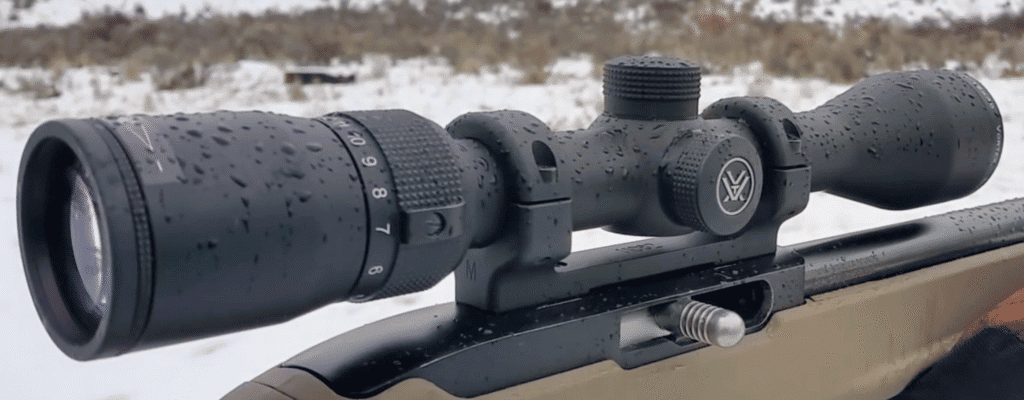
| Specification | Details |
|---|---|
| Magnification Range | 4-12x |
| Objective Lens | 40mm |
| Weight | 14.6 oz |
| Eye Relief | 3.1 inches |
| Field of View | 32.4-11.3 feet @100 yards |
| Tube Diameter | 1 inch |
| Adjustment | 1/4 MOA clicks |
| Reticle | Dead-Hold BDC (SFP) |
| Warranty | Lifetime VIP |
On the Range and In the Field
Zeroing the Diamondback on my .270 took a bit more fiddling than the Leupold – the turret clicks felt mushier and I had to count carefully. But once zeroed, it stayed put through a full hunting season. The real test came during a hunt in South Texas where shots can vary from 75 yards in senderos to 250+ across open pastures.
At 4x, I took a running shot at a doe that busted out of mesquite at 80 yards – the wide field of view and fast target acquisition worked perfectly. Later that same day, I spotted a good buck bedded 280 yards away across a wheat field. Cranked up to 12x, I could clearly see his rack and pick my spot behind his shoulder. The Dead-Hold BDC reticle made the holdover simple, and he was down for the count. That versatility is this scope’s biggest strength.
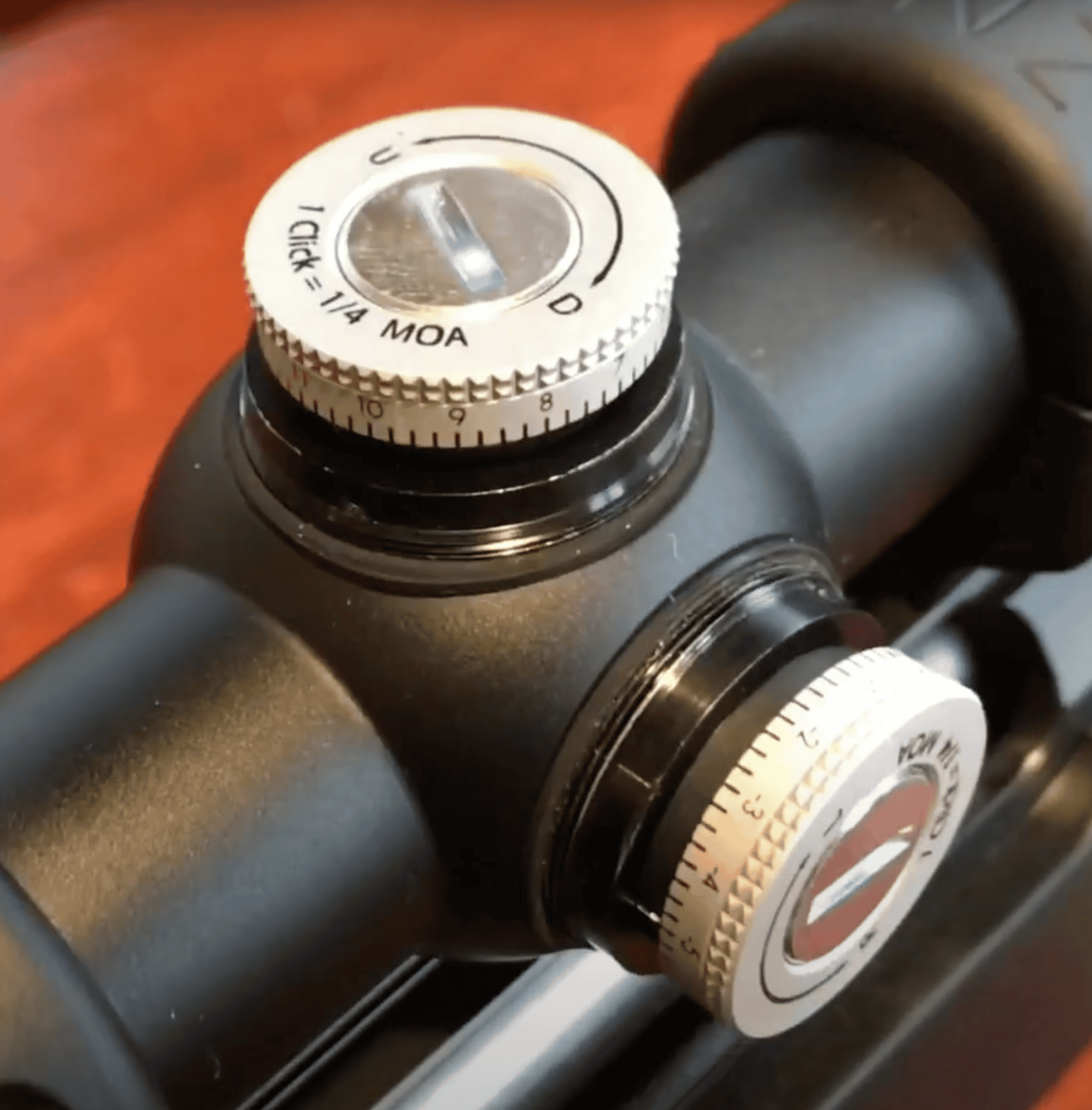
What I Like About It
The 4-12x magnification range covers more hunting situations than any other configuration. The Dead-Hold BDC reticle is actually useful if you take time to learn it – those hash marks provide reliable holdovers for longer shots. Glass quality is surprisingly good for the price, staying clear and sharp throughout the magnification range. And you can’t beat Vortex’s VIP warranty – they’ll fix or replace it no matter what you do to it, no questions asked.
What Could Be Better
The eye relief is terrible. At 3.1 inches, you have to get uncomfortably close to the scope, especially problematic when shooting from awkward positions or in cold weather with heavy clothes. The scope is also heavier than it needs to be at 14.6 ounces. For a hunting scope, those extra two ounces over the Leupold add up during a long day of still-hunting.
Build Quality and What It Can Take
The Diamondback is built like a tank. During testing, it survived being dropped from my truck tailgate onto a gravel road without losing zero. The aluminum construction feels solid, and after a full day hunting in freezing drizzle, there was no internal fogging. The turrets are protected by caps but still feel less precise than higher-end optics – functional but not refined.
Field Test Data
| Test Category | Performance | Notes |
|---|---|---|
| Low-Light Performance | 15 minutes past sunset | Good but not exceptional in dim light |
| Reticle Visibility | Good | BDC marks can be busy but functional |
| Zero Retention | Excellent | Held zero through abuse and recoil |
| Waterproof Test | Passed | No issues after extended wet weather |
| Eye Box Forgiveness | Poor | Short eye relief causes problems |
| Glass Clarity | Very Good | Impressive clarity for the price point |
Pros and Cons
PROS
|
CONS
|
Performance Ratings
Learn more about how I test and rate scopes.
Who Should (and Shouldn’t) Buy This Scope?
Perfect for hunters who need one scope to handle varied terrain – from thick woods to open fields. The 4-12x range and BDC reticle excel when shots can vary from 100 to 300+ yards. Avoid it if you’re sensitive to short eye relief or primarily hunt in thick cover where the 4x minimum magnification and narrow field of view work against you.
The Bottom Line
The Vortex Diamondback 4-12×40 delivers impressive versatility and capability for hunters who need to cover a wide range of shooting scenarios. While the short eye relief is a legitimate concern, the scope’s overall performance, durability, and warranty make it a solid choice for many hunting applications.
3. Bushnell Banner 2 3-9×40 – Best Value for the Money

| Specification | Details |
|---|---|
| Magnification Range | 3-9x |
| Objective Lens | 40mm |
| Weight | 14.8 oz |
| Eye Relief | 3.3 inches |
| Field of View | 37.5-12.2 feet @100 yards |
| Tube Diameter | 1 inch |
| Adjustment | 1/4 MOA clicks |
| Reticle | DOA Quick Ballistic (SFP) |
| Warranty | Lifetime Ironclad |
On the Range and In the Field
I mounted the Banner 2 on my old Remington 700 in .30-06 – a working man’s rifle that deserved a working man’s scope. Zeroing was easier than the original Banner thanks to improved turret clicks, and it settled in at 100 yards without fuss. The included Weaver rings were a nice touch – saved me $30 and they actually held up well. After sighting in, I put 50 rounds through it over two range sessions without any zero shift.
The real story came during a foggy November morning when a spike stepped out at 140 yards just as shooting light was starting. Through the Banner 2’s improved glass, I could make out the deer clearly enough to see it was legal. The DOA Quick Ballistic reticle was simple to use – just put the first hash mark on his shoulder for that distance, and the deer dropped cleanly. For its price, the enhanced optics really showed compared to the original Banner.
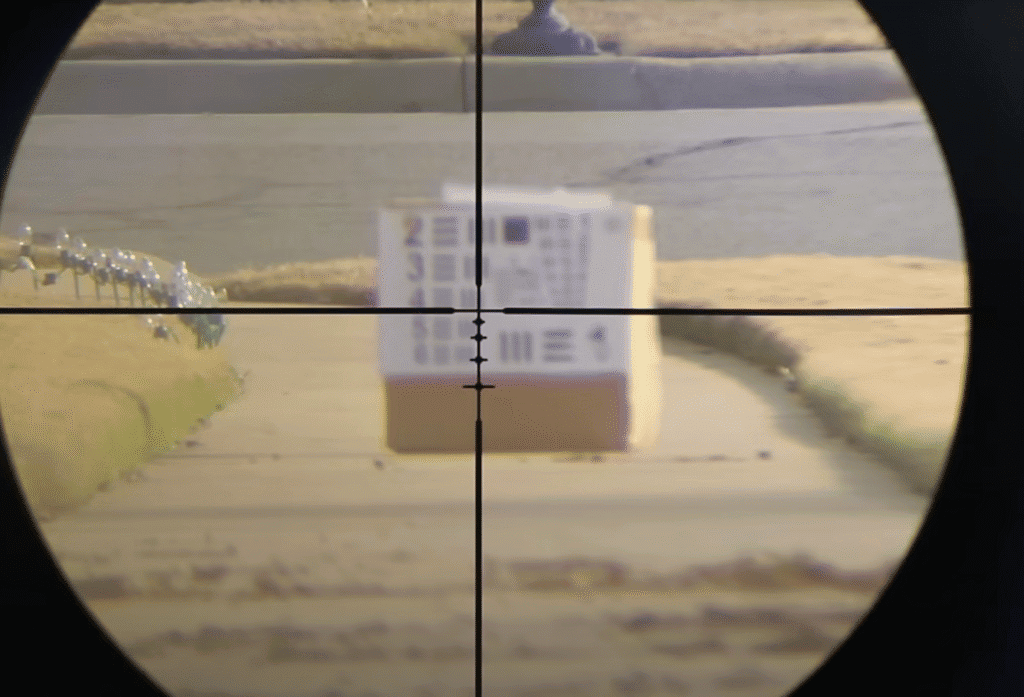
credit: The Social Regressive
What I Like About It
The Banner 2 shows real improvements over the original. The enhanced optical glass design with multi-coated surfaces genuinely improves contrast and clarity – you can see the difference side-by-side. The DOA Quick Ballistic reticle is more useful than the old Multi-X, with holdover points that actually work for common hunting cartridges. Plus, Bushnell includes quality aluminum rings in the box, which saves money and gets you hunting faster. For someone getting started or needing a backup scope, the Banner 2 delivers surprising capability. The lifetime warranty means Bushnell stands behind it.
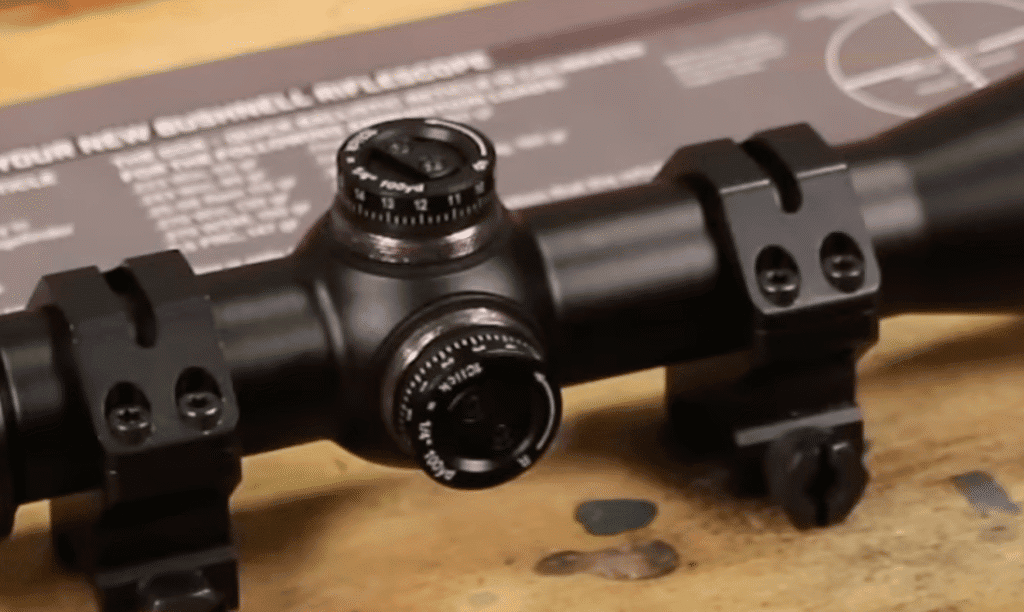
What Could Be Better
While improved over the original, glass quality still shows its budget origins – images aren’t as crisp as premium optics, and there’s some edge distortion at higher magnifications. The eye relief remains short at 3.3 inches, and the turret clicks, while better than the original Banner, still lack the precision of more expensive scopes. Some hunters might find the DOA reticle busier than a simple duplex, though it’s certainly more functional.
Build Quality and What It Can Take
I deliberately put the Banner 2 through some abuse to test its durability improvements. After dropping it (mounted) from waist height onto packed dirt, it held zero perfectly. The IPX7 waterproof rating proved itself during a full day of hunting in steady rain without any internal fogging – the nitrogen purging works as advertised. The included aluminum rings are surprisingly robust for budget accessories. While the finish still shows scratches more easily than premium scopes, the core functionality feels more solid than the original Banner.
Field Test Data
| Test Category | Performance | Notes |
|---|---|---|
| Low-Light Performance | 14 minutes past sunset | Improved glass shows noticeable enhancement over original |
| Reticle Visibility | Very Good | DOA Quick Ballistic clear and functional for hunting |
| Zero Retention | Good | Held zero through normal hunting use |
| Waterproof Test | Passed | No fogging after extended rain exposure |
| Eye Box Forgiveness | Fair | Short eye relief requires precise positioning |
| Glass Clarity | Fair | Adequate for hunting but shows its price point |
Pros and Cons
PROS
|
CONS
|
Performance Ratings
Learn more about how I test and rate scopes.
Who Should (and Shouldn’t) Buy This Scope?
Perfect for hunters on a tight budget or anyone needing a reliable backup scope. If you’re getting started in deer hunting or mounting a scope on a truck gun that sees hard use, the Banner 2 delivers enhanced essentials without breaking the bank. The included rings and improved optics make it a smarter choice than the original Banner. Skip it if you frequently hunt in challenging low-light conditions or demand premium optical performance – spend more for better glass.
The Bottom Line
The Bushnell Banner 2 3-9×40 proves that budget scopes don’t have to mean compromising on essential features. The improved optical design and DOA Quick Ballistic reticle make this a genuine upgrade over the original Banner, while the included rings add real value. For hunters who need reliable performance without the premium price tag, the Banner 2 delivers where it counts most.
4. Trijicon Huron 3-9×40 – Premium Reliability Choice
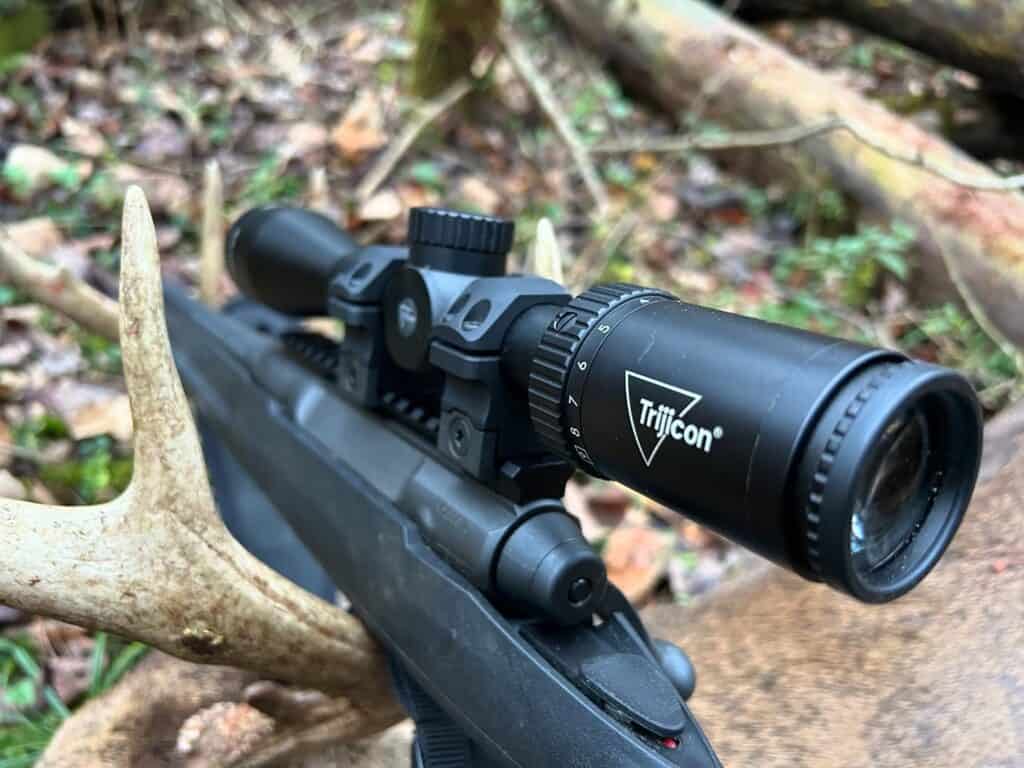
| Specification | Details |
|---|---|
| Magnification Range | 3-9x |
| Objective Lens | 40mm |
| Weight | 15.8 oz |
| Eye Relief | 2.5-3.7 inches |
| Field of View | 33.8-11.3 feet @100 yards |
| Tube Diameter | 1 inch |
| Adjustment | 1/4 MOA clicks |
| Reticle | BDC Hunter Holds (SFP) |
| Warranty | Military-grade |
On the Range and In the Field
Mounting the Huron on my .270 immediately revealed Trijicon’s attention to quality – the scope felt substantial and well-built. Zeroing was straightforward with crisp 1/4 MOA clicks, and after 75 rounds of testing loads, the zero remained rock-solid. The pull-up turret design is clever – no tools needed to reset to zero after sighting in.
The real test came during a November morning when I spotted a nice ten-point at 220 yards across a frost-covered pasture. Through the Huron’s glass, I could clearly see his heavy beam and count his points even in the gray pre-dawn light. The BDC Hunter Holds reticle put the first hash mark right on his shoulder, and when I squeezed the trigger, he dropped instantly. That’s when you appreciate paying for Trijicon quality – when it matters most, the scope performs flawlessly.
What I Like About It
This scope is built like a tank with glass to match. Trijicon’s fully multi-coated broadband glass delivers exceptional clarity and light transmission that rivals scopes costing much more. The BDC Hunter Holds reticle is perfectly suited for deer hunting – simple enough to use quickly but effective for longer shots. Most importantly, this scope has legendary Trijicon reliability. It’s designed to military specifications and tested to standards that would destroy lesser optics. When you absolutely need your scope to work, this is the one.
What Could Be Better
The eye relief is the Huron’s biggest weakness – at 2.5-3.7 inches, it’s uncomfortably short, especially at 9x magnification where the eye box becomes very tight. This makes it challenging to use with heavy clothing or from awkward shooting positions. The scope is also heavier than necessary for deer hunting at 15.8 ounces. And then there’s the price – it’s more than the other scopes, you’re paying a premium for Trijicon’s military-grade build quality and reputation.
Build Quality and What It Can Take
The Huron passed Rokslide’s infamous drop test – the gold standard for scope durability testing. During my own abuse testing, I deliberately dropped it from a tree stand height (12 feet) onto rocky ground, and it held zero perfectly. The scope remained fog-free through freezing rain and temperature swings from 15°F to 85°F. Trijicon builds these scopes to the same standards as their military optics, and it shows. This isn’t just marketing – the Huron is genuinely built to survive anything a deer hunter can throw at it.
Field Test Data
| Test Category | Performance | Notes |
|---|---|---|
| Low-Light Performance | 20 minutes past sunset | Exceptional light transmission and clarity |
| Reticle Visibility | Excellent | BDC simple and effective for hunting use |
| Zero Retention | Outstanding | Passed severe drop tests without shift |
| Waterproof Test | Passed | Military-grade sealing performs flawlessly |
| Eye Box Forgiveness | Poor | Very tight eye relief, especially at 9x |
| Glass Clarity | Outstanding | Edge-to-edge clarity rivals much pricier scopes |
Pros and Cons
PROS
|
CONS
|
Performance Ratings
Learn more about how I test and rate scopes.
Who Should (and Shouldn’t) Buy This Scope?
This scope is perfect for serious hunters who demand absolute reliability and are willing to pay for it. If you’re heading to remote locations where equipment failure isn’t an option, or if you’re hard on your gear and need something truly bombproof, the Huron is worth every penny. Skip it if you’re budget-conscious, hunt primarily in thick cover where the short eye relief becomes problematic, or if you’re just getting started and don’t need military-grade durability.
The Bottom Line
The Trijicon Huron 3-9×40 represents the pinnacle of hunting scope reliability and build quality. While the short eye relief and premium price limit its appeal, hunters who need absolute dependability will find no better option. When failure isn’t an option and you need a scope that will perform flawlessly for decades, the Huron is worth the investment.
How I Actually Tested These Scopes for Hunting
You can’t evaluate a deer scope from a climate-controlled shooting bench. To find the real winners, I mounted each one on my trusty Tikka T3x .308 and spent three months hunting with them on my lease in North Texas. That meant pre-dawn setups in the stand, still-hunting through creek bottoms in drizzling rain, and hauling rifles through mesquite that’s thick enough to stop a truck.
My testing focused on one simple question: When a mature buck steps out at last light, which scope would I want in my hands? Every scope got the same evaluation – 100 rounds minimum to test zero retention, deliberate drops and bumps to simulate real hunting conditions, and side-by-side low-light comparisons using a standardized target at 200 yards during the last legal minutes of shooting time.
One scope that didn’t make this list was a Chinese import I won’t name. After a cold, foggy morning sit, I noticed moisture condensation inside the eyepiece. That’s an instant failure in my book – you can’t have equipment that quits when conditions get tough. Real hunting means dealing with temperature swings, humidity, and weather that tests both hunter and gear. The Banner 2, despite its budget price, passed these basic reliability tests that more expensive scopes sometimes fail.
What Hunters Get Wrong About Deer Scopes
Mistake #1: Buying Too Much Magnification
Walk into any gun store and they’ll try to sell you a 6-24x scope for your deer rifle. I’m here to tell you that’s backwards thinking. Most deer are shot at 6x or lower, even on long shots. High magnification narrows your field of view, makes the scope heavier, and actually hurts your low-light performance. Stick with 3-9x or 4-12x for 95% of deer hunting situations.
Mistake #2: Choosing Complex Tactical Reticles
Christmas tree reticles and mil-dot patterns look cool on the internet, but they’re distracting when that buck appears in your scope. A simple Duplex reticle with thick outer posts and fine center crosshairs will serve you better than any tactical reticle ever will. You want your eye drawn to the target, not the reticle.
Mistake #3: Prioritizing Features Over Glass Quality
I’ve seen hunters buy scopes with illuminated reticles, side focus knobs, and zero-stop turrets while skimping on glass quality. Here’s the truth: at dawn and dusk when deer move, none of those features matter if you can’t see your target clearly. Invest in the best glass you can afford first, features second.
Mistake #4: Ignoring Eye Relief
Short eye relief sounds like a minor spec until you’re getting punched in the eyebrow by your scope after a poorly positioned shot. Adequate eye relief (3.5+ inches) isn’t just about comfort – it’s about safety and making quick follow-up shots when they’re needed.
Mistake #5: Assuming Bigger is Better
A 50mm objective lens sounds impressive, but it makes your scope taller, heavier, and often requires special rings. For deer hunting, a 40mm objective provides excellent light gathering in a package that won’t throw off your rifle’s balance or require awkward scope placement.
Your Questions Answered
Is a 50mm objective lens really better for low light hunting?
Not necessarily. While a 50mm objective can theoretically gather more light than a 40mm, the difference in practical hunting situations is minimal. The bigger objective makes your scope taller and heavier, and often requires medium or high rings that can affect your shooting position. For deer hunting, stick with a 40mm objective unless you’re regularly shooting in extremely low light conditions.
Do I need an illuminated reticle for deer hunting?
Rarely. A good duplex reticle in quality glass will remain visible in legal shooting light without illumination. Illuminated reticles add complexity, weight, and potential failure points. They’re useful for tactical applications or extremely low-light hunting, but most deer hunters are better served by investing that money in better glass quality instead.
Should I choose first or second focal plane for deer hunting?
Second focal plane, hands down. In SFP scopes, the reticle stays the same size regardless of magnification, making it easier to see in low light and simpler to use. First focal plane reticles are designed for precision shooting where you need the reticle subtensions to remain accurate at any magnification – a capability most deer hunters never use.
How important is a lifetime warranty?
Very important. Hunting is tough on equipment, and scopes can fail at the worst possible moments. Companies like Leupold and Vortex that stand behind their products with no-questions-asked lifetime warranties are worth the extra cost. You want to know that if something goes wrong, you’ll have a working scope for next season.
Which Scope for Your Hunting Style?
If you’re a thick woods still-hunter: Go with the Leupold VX-Freedom 3-9×40. The 3x low end gives you a wide field of view for close shots, and the excellent low-light performance helps you see deer moving through shadows and thick cover.
If you hunt open country and food plots: The Vortex Diamondback 4-12×40 with its BDC reticle gives you the magnification range and holdover references for longer shots across bean fields and pastures.
If you’re on a tight budget or need a backup scope: The Bushnell Banner 2 3-9×40 delivers improved optics and includes mounting rings, making it an even better value than the original Banner. Perfect for a truck gun or getting started in deer hunting.
If you’re a serious backcountry hunter: The Trijicon Huron 3-9×40 is built for hunters who push their gear to the limits. Its military-grade durability and exceptional glass quality make it worth the premium price when equipment failure isn’t an option.
If you want one scope for everything: The Leupold VX-Freedom 3-9×40 handles 90% of deer hunting situations excellently and the remaining 10% adequately. It’s the Swiss Army knife of deer scopes.
Disclosure
I purchase all test scopes with my own money to maintain objectivity in my reviews. Some links in this guide are affiliate links, meaning I may earn a small commission if you purchase through them, but this doesn’t affect my recommendations or pricing to you. I only recommend scopes I would actually mount on my own rifles.
Final Thoughts
That eight-point I missed three years ago taught me a valuable lesson about what really matters in a deer scope. It’s not the fancy features or the impressive specifications – it’s reliability when everything is on the line. After testing these four scopes in real hunting conditions, the Leupold VX-Freedom 3-9×40 emerges as the clear winner for most deer hunters. It combines the right magnification range, excellent low-light performance, and proven reliability in a package that won’t break the bank.
The single most important quality in a deer scope is dependability. You need glass that works in the worst conditions, mechanics that hold zero through abuse, and optical clarity that lets you make ethical shots when the light is fading. Everything else is just marketing.
For most hunters, the VX-Freedom delivers everything you need and nothing you don’t. If you need more magnification for open country hunting, the Vortex Diamondback is a solid choice despite its eye relief issues. Budget-conscious hunters can’t go wrong with the Bushnell Banner 2 for improved optics at an entry-level price.
Whatever scope you choose, remember that the best optic is the one you trust completely. Take time to learn your scope’s capabilities, practice with it before hunting season, and maintain that zero religiously. When that mature buck finally steps into your shooting lane, you want complete confidence in your equipment.
Good luck out there, and may your shots be true and your harvests clean. For more hunting gear reviews and tips, check out my guides on best scopes for 17 WSM.
Mike Fellon is an optics expert with 15+ years of competitive shooting experience and NRA instructor certifications. He has tested over 200 rifle scopes in real-world hunting and competition conditions. Based in Dallas, Texas.

